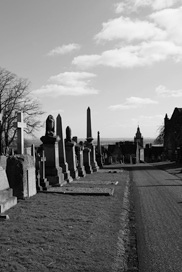Charles Haimes
Gunner and Castle Hero
1808 – 1855
On the evening of 18th November 1855 a piece of coal fell from the grate in the room of Ensign Fawkes, 90th Stirling Militia, in the Governor’s House in the barracks of the old part of Stirling Castle. By 11.00 p.m. the entire room was on fire, with the flames spreading fast. Lack of light and water hampered the rescue effort and before long there were fears that the entire Castle would be overcome.
One of the powder magazines was situated next to the burning building and many of the residents of the top of the town area abandoned their homes and fled to friends in other parts of Stirling. Their fears were misplaced however, as the main powder stores were situated further down the rock. If the fire had reached the stores, as the Stirling Journal noted at the time, ‘…the result would have been the almost total destruction of all the buildings within a long distance of the Castle.’ As it was, the famed Douglas Room was totally destroyed, and damage to the Castle was estimated to be in the region of over £1000.
That the fire did not spread any further was due in no small measure to several of the Militia, one of whom was Gunner Charles Haimes. A native of Staffordshire, Gunner Haimes had been billeted at Stirling for eight years; his army career in the Royal Artillery had taken him to Woolwich, Cork, and as far afield as Bermuda. Gunner Haimes was in charge of the Armoury and, realising the outcome should the flames reach the powder store, spared no effort in ensuring they did not. Soon after, he contracted a fever caused by overexertion and exposure and died on December 1st at the age of only 47. A full military funeral was held for him and he is buried here in the Old Town Graveyard. He left a widow, Jane, and nine children, the youngest of whom, James, celebrated his first birthday on the day that his father died. A public subscription was set up for Jane and her family, who later emigrated to America, but it was insufficient to erect a gravestone. He is buried in the old military burial ground at the west end of the “Pithy Mary.”

